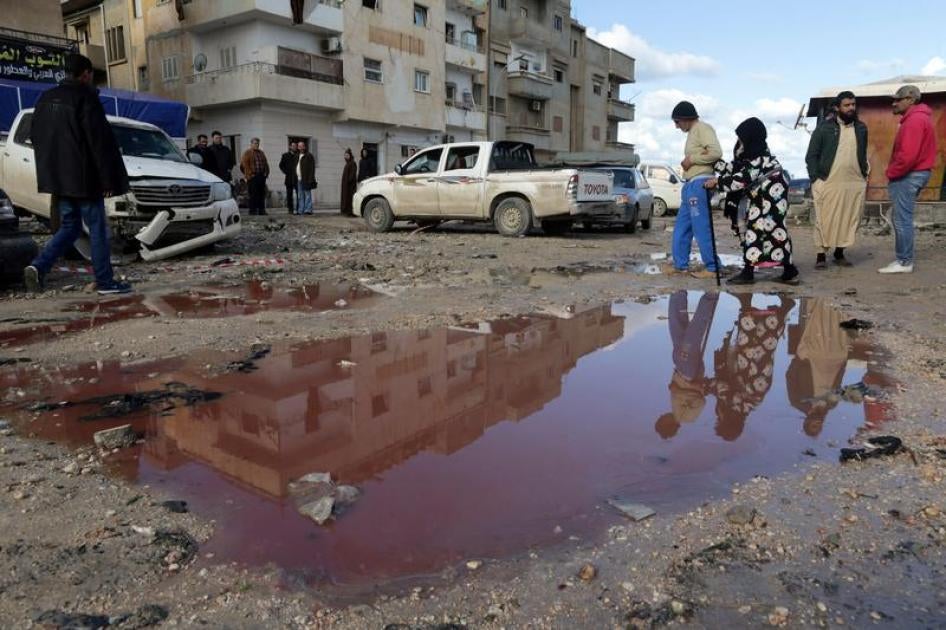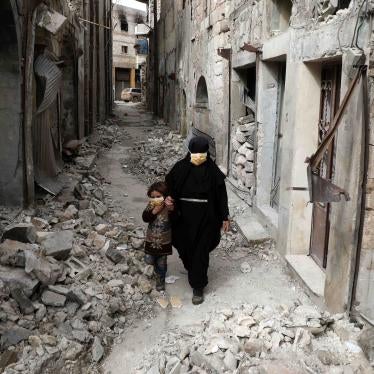(Beirut) – Unidentified armed groups detonated two car bombs in front of a mosque in the eastern Libyan city of Benghazi on January 23, 2018, killing at least 34 people and wounding over 90, Human Rights Watch said. According to spokespersons for the two main hospitals for emergency and trauma services in Benghazi, the majority of victims were civilians, with at least three young children among the dead.
“Planting bombs outside a civilian mosque, in particular when the timing is likely to inflict maximum casualties among civilians, is a war crime,” said Hanan Salah, senior Libya researcher at Human Rights Watch. “Civilians in Benghazi are unacceptably bearing the brunt of this conflict.”
The car bombs exploded within 15 to 30 minutes of each other after 8 p.m. on January 23, in front of the Baya’at al-Radwan mosque in the Salmani neighborhood of Benghazi, local hospital sources said. The first attack occurred just as worshippers were leaving after evening prayers known as “al-Isha,” killing three people and injuring six.
The second blast occurred as civilians and responders from the security forces arrived at the scene to evacuate the wounded and dead, hospital sources and news reports said. The second bomb apparently caused the majority of deaths and injuries. All dead and injured were male and included children as young as 9. No group has taken responsibility for the attacks.
Serious violations of the laws of war can amount to war crimes. These include deliberately targeting civilians or civilian objects, including mosques, or carrying out attacks in the knowledge that they are likely to result in indiscriminate or disproportionate death or injury to civilians.
Fadia al-Barghathi, spokesperson at the al-Jalaa Hospital in Benghazi, one of the city’s main hospitals for emergency and trauma services, told Human Rights Watch in a telephone call on January 24 that al-Jalaa was the first to receive the injured and dead in the immediate aftermath of both bombings, given the proximity of the hospital to the mosque. Al-Barghathi said that the hospital soon reached its capacity and had to transfer wounded patients to the Benghazi Medical Center, also known as Hospital 1,200, and other private hospitals. She said that among the dead and injured, civilians far outnumbered any security personnel, and included two children, ages 9 and 11.
Al-Barghathi said that the victims’ injuries had been caused by a major detonation. Two of the victims at al-Jalaa had severed heads, and first responders collected multiple severed limbs. She said that al-Jalaa hospital had confirmed at least 25 deaths, including some victims who died at the hospital, and treated another 51 wounded people.
Khalil Qweider, spokesperson at the Benghazi Medical Center, who spoke with Human Rights Watch by telephone on January 24, said that the hospital had confirmed an additional 9 civilian deaths from the incident, and another 36 injured, among them some security force members. Qweider said that the Libyan-German hospital treated 7 injured people and al-Safwa hospital another 5. He said that on January 24, 9 people injured in the incident had surgery for their wounds, some of whom remained in critical condition.
Human Rights Watch has not seen any evidence to suggest that at the time of the attack, Baya’at al-Radwan mosque was being used for anything other than evening prayers.
On January 24, accounts appeared on multiple news sites and social media displaying undated photos that allegedly show a commander from the Libyan National Army forces (LNA), Mahmoud al-Werfalli, wanted for war crimes by the International Criminal Court (ICC), appearing to execute 10 individuals, assumed to be detainees as they were dressed in blue prison uniforms. Human Rights Watch reviewed a video recording purportedly from the same incident that appeared on social media, showing the apparent execution of 10 men wearing blue uniforms. The men, who in the video are kneeling and blindfolded with their hands tied behind their backs, are shot one after the other by a bearded man in military fatigues, as a large crowd of onlookers can be seen cheering.
The United Nations mission in Libya (UNSMIL) issued a call for the immediate hand over of al-Werfalli to the Hague. Human Rights Watch is unable to verify the authenticity of these photos or the video, but summary executions such as those portrayed in both constitute war crimes.
Armed conflict, insecurity, and political divisions have plagued Libya since May 2014, when General Khalifa Hiftar, commander of the LNA in eastern Libya, declared war on “terrorism” in Benghazi and announced a continuing military operation, “Operation Dignity.” Although the LNA declared Benghazi “liberated” from opposing forces known as the Benghazi Revolutionaries Shura Council (BRSC) earlier in January, there have been new clashes, individual attacks against political and security officials, and extrajudicial killings.
The laws of war strictly prohibit attacks that target civilians or civilian structures, including mosques, unless they were being used for military purposes. The laws of war also prohibit indiscriminate attacks, which fail to distinguish between military and civilian targets, and disproportionate attacks, in which the civilian casualties or damage to civilian buildings is excessive considering the military advantage gained. All feasible precautions must be taken by all parties to the conflict to avoid, and in any event, to minimize incidental loss of civilian life, injury to civilians, and damage to civilian objects.
“Authorities in eastern Libya should conduct a transparent and effective investigation into the incidents, and to the extent possible, prosecute those found to be responsible for criminal attacks,” Salah said.









